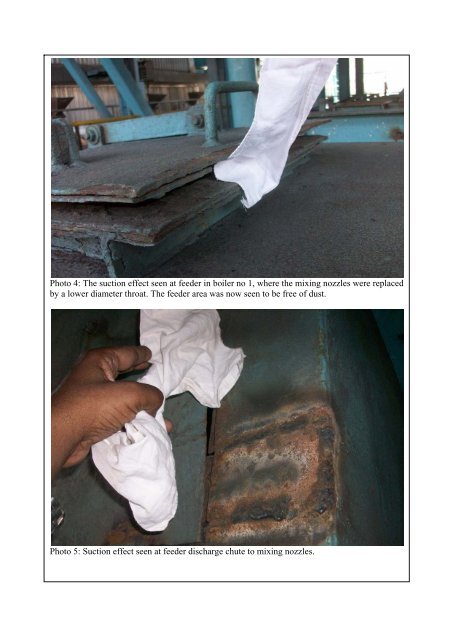Dust Nuisance at Fuel Feed System in AFBC boiler
The new mixing nozzle had reduced the air flow as indicated by the air flow measurement and the power consumption. The high suction that could be created helped in sucking the wet coal without causing a bridging effect and venturi throat. The fuel feeder floor is now clean and the leg chute jamming by wet coal is reduced drastically. The fuel feeder was seen to be at high vacuum as can be seen from photographs. Comparison of power consumption by PA fan in boiler 1 & 2 The new mixing nozzle consumed 107.4 kW as against 177.4 kW to produce the minimum vacuum at throat. However the boiler operators now preferred to keep higher header pressure so that the bridging of wet coal in leg chute was reduced greatly. The power consumed for the same is 120.5 kW. On the net comparing boiler 1 & 2, there is a power saving of 57 kW. What could be the reason for reduced fan efficiency? For the condition of 1520 mmWC header pressure, the fan power should have been 86 kW only (with an efficiency of 70% as per fan performance curve) as against present 120.5 kW. If the header pressure was only 1304 mmWC, with a fan efficiency of 70%, the fan power should have been only 50 kW. At least one can say, there is a loss of 120.5-86 = 34.5 kW now by virtue of poor efficiency of PA fan. The reason can be defective inlet conditions assuming the impeller design is correct. It is possible that the suction box is undersized producing an effect of 90 deg turn at inlet of fan. Further the IGV provided at fan inlet with a high entry velocity can be an added disadvantage. The preferred free length at front of fan has to be three times the inlet diameter. The recirculation of air flow through standby fan is possible. Guillotine gate eliminates the possibility of recirculation. Problem bridging in mixing inlet chute & leg chute During the visit, the problem of leg chute choking was studied. When the mixing nozzle develops negative pressure, the fuel that is fed into the mixing nozzle flows freely. In case of any occasion of choking at throat cross by a coal powder lump, the positive pressure created at throat leads to bridging of wet coal in the mixing nozzle inlet chute. This is unavoidable. On inspection of each chute at mixing nozzle inlet, the following points were noted to be a concern for bridging of wet coal. It was seen that the SS liner plates were tack / stitch welded to chutes. These weld beads offered as sites for the dust to build up. Instead of liner plates, the chute should have been made of SS plates. Or else the liner plates should have been plug welded from back, through some drilled holes in the chute. It was seen that the flange setting was not proper in a chute that was removed for inspection. It was seen that the packing ropes were projecting inside the coal flow path. These can form sites for coal dust to build up. Final conclusion The mixing nozzles have met the intentions of its purpose of achieving suction effect with lesser air flow. The mixing nozzle inlet chutes need to be corrected for smooth flow of coal. The PA fan needs a properly designed suction box to reduce the power consumption.
Photo 4: The suction effect seen at feeder in boiler no 1, where the mixing nozzles were replaced by a lower diameter throat. The feeder area was now seen to be free of dust. Photo 5: Suction effect seen at feeder discharge chute to mixing nozzles.
- Page 1 and 2: DUST NUISANCE AT FUEL FEED SYSTEMS
- Page 3 and 4: The theory As long as the fluid spe
- Page 6 and 7: PART 2: AIR FLOW MEASUREMENT IN PA
- Page 8 and 9: = 15.364 m/s Actual power consumpti
- Page 12 and 13: Photo 6: The effect of new mixing n
- Page 14 and 15: Photo 10: Coal dust seen to build u
- Page 16 and 17: Photo 15: In one of the mixing nozz
- Page 18 and 19: Figure 2: This is a recommended con
- Page 20 and 21: Translated from - Pandit Shriram Sh
- Page 22 and 23: LOVELY ARTICLE SHARED ------- IN A
- Page 24 and 25: Jane seemed to suddenly wake up. Sh
Photo 4: The suction effect seen <strong>at</strong> feeder <strong>in</strong> <strong>boiler</strong> no 1, where the mix<strong>in</strong>g nozzles were replaced<br />
by a lower diameter thro<strong>at</strong>. The feeder area was now seen to be free of dust.<br />
Photo 5: Suction effect seen <strong>at</strong> feeder discharge chute to mix<strong>in</strong>g nozzles.



